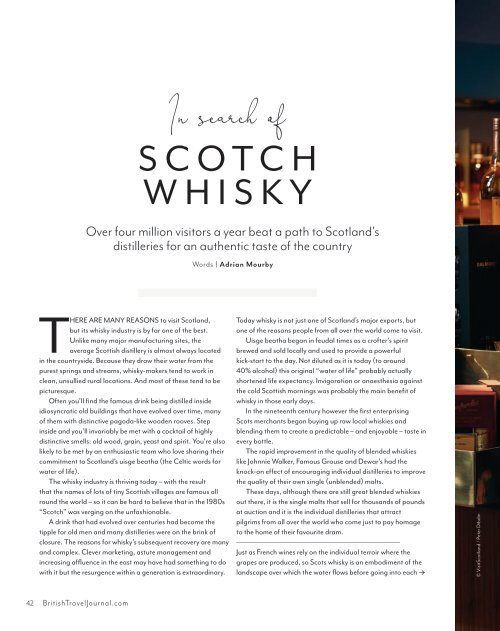British Travel Journal | Summer 2019
Hooray it’s the summer! – and all we want to do is travel - to see as much of the British Isles in this glistening sunshine as we possibly can, and with tourism in the UK rising rapidly from previous years, it seems we are not alone.... Inside this issue we tour the new South West Coast 300 driving route in Scotland, Nathan Outlaw takes our food columnist, Chantal Borciani on a gourmand’s tour of the spectacular Cornish coastline, we visit the wonderful new Machrie Hotel on the Isle of Islay, ‘In search of Scotch Whisky’, we go behind-the-scenes at Wimbledon, learn to ride the waves at surfer’s paradise, Fistral Beach, Newquay, we join a cookery class to improve the culinary skills, find adventure after-dark with our 10 unique experiences - and not to mention all of our regulars too - with the latest Travel News, What's On Cultural Agenda, and featured destinations and travel itineraries we hope will inspire you to book that holiday you have been dreaming of too!
Hooray it’s the summer! – and all we want to do is travel - to see as much of the British Isles in this glistening sunshine as we possibly can, and with tourism in the UK rising rapidly from previous years, it seems we are not alone.... Inside this issue we tour the new South West Coast 300 driving route in Scotland, Nathan Outlaw takes our food columnist, Chantal Borciani on a gourmand’s tour of the spectacular Cornish coastline, we visit the wonderful new Machrie Hotel on the Isle of Islay, ‘In search of Scotch Whisky’, we go behind-the-scenes at Wimbledon, learn to ride the waves at surfer’s paradise, Fistral Beach, Newquay, we join a cookery class to improve the culinary skills, find adventure after-dark with our 10 unique experiences - and not to mention all of our regulars too - with the latest Travel News, What's On Cultural Agenda, and featured destinations and travel itineraries we hope will inspire you to book that holiday you have been dreaming of too!
Create successful ePaper yourself
Turn your PDF publications into a flip-book with our unique Google optimized e-Paper software.
In search of<br />
SCOTCH<br />
WHISKY<br />
Over four million visitors a year beat a path to Scotland's<br />
distilleries for an authentic taste of the country<br />
Words | Adrian Mourby<br />
THERE ARE MANY REASONS to visit Scotland,<br />
but its whisky industry is by far one of the best.<br />
Unlike many major manufacturing sites, the<br />
average Scottish distillery is almost always located<br />
in the countryside. Because they draw their water from the<br />
purest springs and streams, whisky-makers tend to work in<br />
clean, unsullied rural locations. And most of these tend to be<br />
picturesque.<br />
Often you’ll find the famous drink being distilled inside<br />
idiosyncratic old buildings that have evolved over time, many<br />
of them with distinctive pagoda-like wooden rooves. Step<br />
inside and you’ll invariably be met with a cocktail of highly<br />
distinctive smells: old wood, grain, yeast and spirit. You’re also<br />
likely to be met by an enthusiastic team who love sharing their<br />
commitment to Scotland’s uisge beatha (the Celtic words for<br />
water of life).<br />
The whisky industry is thriving today – with the result<br />
that the names of lots of tiny Scottish villages are famous all<br />
round the world – so it can be hard to believe that in the 1980s<br />
“Scotch” was verging on the unfashionable.<br />
A drink that had evolved over centuries had become the<br />
tipple for old men and many distilleries were on the brink of<br />
closure. The reasons for whisky’s subsequent recovery are many<br />
and complex. Clever marketing, astute management and<br />
increasing affluence in the east may have had something to do<br />
with it but the resurgence within a generation is extraordinary.<br />
Today whisky is not just one of Scotland’s major exports, but<br />
one of the reasons people from all over the world come to visit.<br />
Uisge beatha began in feudal times as a crofter’s spirit<br />
brewed and sold locally and used to provide a powerful<br />
kick-start to the day. Not diluted as it is today (to around<br />
40% alcohol) this original “water of life” probably actually<br />
shortened life expectancy. Invigoration or anaesthesia against<br />
the cold Scottish mornings was probably the main benefit of<br />
whisky in those early days.<br />
In the nineteenth century however the first enterprising<br />
Scots merchants began buying up raw local whiskies and<br />
blending them to create a predictable – and enjoyable – taste in<br />
every bottle.<br />
The rapid improvement in the quality of blended whiskies<br />
like Johnnie Walker, Famous Grouse and Dewar’s had the<br />
knock-on effect of encouraging individual distilleries to improve<br />
the quality of their own single (unblended) malts.<br />
These days, although there are still great blended whiskies<br />
out there, it is the single malts that sell for thousands of pounds<br />
at auction and it is the individual distilleries that attract<br />
pilgrims from all over the world who come just to pay homage<br />
to the home of their favourite dram.<br />
________________________________________________________<br />
Just as French wines rely on the individual terroir where the<br />
grapes are produced, so Scots whisky is an embodiment of the<br />
landscape over which the water flows before going into each à<br />
© VisitScotland / Peter Dibdin<br />
42 <strong>British</strong><strong>Travel</strong><strong>Journal</strong>.com


















